Scotch Macaskill's Wildlife Blog
IMPORTANT: Please note that from April 2009 this Blog's Web address changed as a result of a switch in the blogging platform we use. It's still an integral part of the Wildlife Pictures Online website and, we hope, will continue providing entertaining and enjoyable content in the form of wildlife images, news, views and information.
For the most recent posts, links, and other resources, please visit the new Wldlife Photography Blog.
|
Today's Picture: Hippo Making Waves
April 4, 2007
|
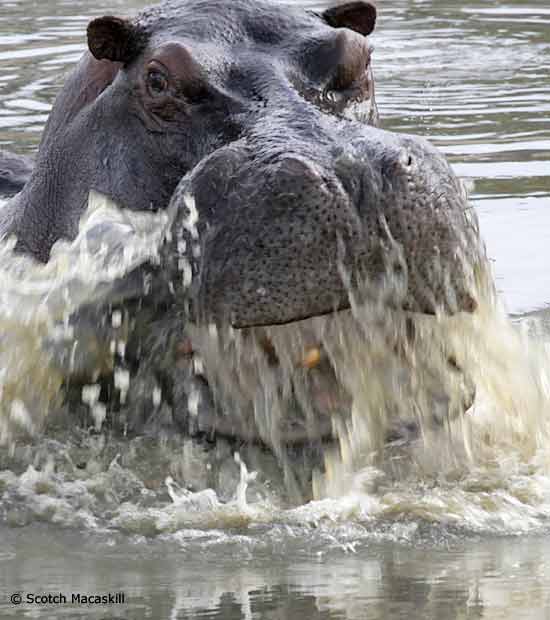
Photo Details: Hippopotamus (Hippopotamus amphibius) breaching the surface in an impressive display of power, Santawani, Botswana.
Camera: Canon EOS 400D; Lens: Canon 100-400 IS Zoom; Focal Length: 390mm; Shutter speed: 1/100; Aperture: f11; ISO: 400.
Additional Info: The picture above is of a bull or male hippo. He, together with a female and juvenile, share one of the pools in the Santawani area adjacent to Botswana's Moremi Game Reserve.
Although our Landrover was parked some way from the water's edge, the big fella soon made it clear this was his territory, warning us to keep our distance. In the picture above he breaches the surface with a sudden surge of power, splashing water and creating waves.
He followed this impressive show with a very different threat display, turning his rear towards us, defecating, and simultaneously shaking his tale, showering dung in all directions. The finale to his repertoire was a classic "yawn", the massive jaws opening wide to showcase fearsome upper and lower canines and tusk-like incisors.
Although hippos have the reputation of killing more people than any other of Africa's wildlife, there doesn't appear to be any hard evidence to back this up. They are nevertheless dangerous animals, particularly when threatened. Adult hippos should not be underestimated because of their clumsy and lumbering appearance. On land they'll outrun a person, so should never be approached when they're sunbathing on riverbanks or near the water's edge.
|
Today's Picture: African Wild Cat
April 9, 2007
|
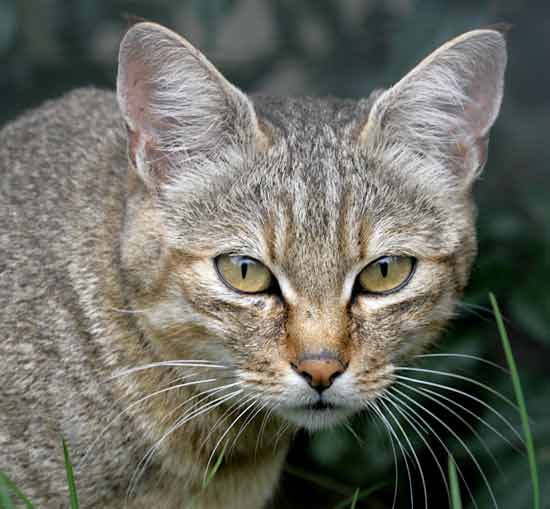
Photo Details: Portrait of African wild cat (Felis Libyca), captive specimen, Natal Zoological Gardens, Pietermaritzburg, South Africa.
Camera: Canon EOS 400D; Lens: Canon 100-400 IS Zoom; Focal Length: 180mm; Shutter speed: 1/160; Aperture: f5.6; ISO: 400.
Additional Info: "A wild tabby cat" - that's how Richard Estes describes the African wild cat in his book, Behavior Guide to African Mammals. And the one in the photograph could certainly be a good-looking domestic cat, except that it's in captivity, its home a wire-mesh enclosure.
African wild cats are usually gray or tan, but can vary in color from orange to black, depending on their habitat. The main features that distinguish them from domestic cats are the ears - rufous, unmarked and almost translucent - and longer legs that give the wild cat a more upright seated posture.
The forehead and cheeks are striped and the tail ringed, ending typically in a black tip. These features tend to be diluted or lost when wild cats breed with house cats - which are in essence domesticated wild cats.
|
Today's Picture: Rhino Wallowing in Mud
April 10, 2007
|
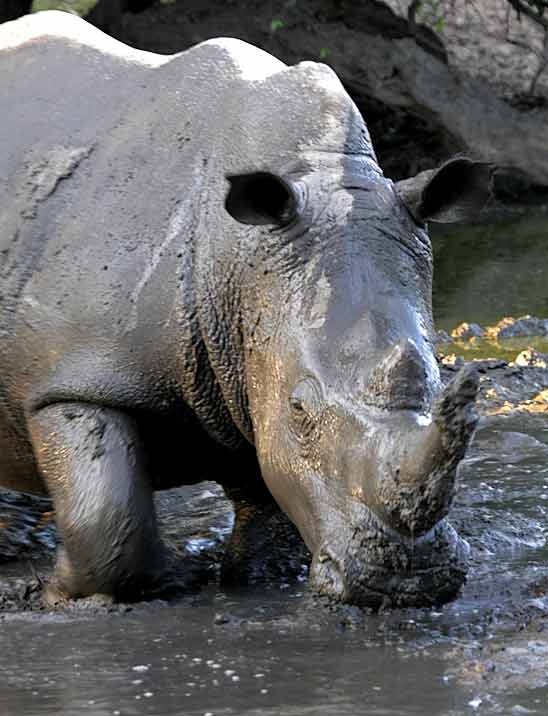
Photo Details: White Rhino (Ceratotherium simum) taking a mud bath in late afternoon, Khama Rhino Sanctuary, Botswana.
Camera: Canon EOS 400D; Lens: Canon 100-400 IS Zoom; Focal Length: 200mm; Shutter speed: 1/50; Aperture: f5.0; ISO: 400.
Additional Info: The Khama Rhino Sanctuary, situated near Serowe in eastern Botswana, is a small (4,300 ha) wildlife sanctuary established primarily as a breeding ground for white rhino. The site provides excellent habitat for rhinos and other grazing animals, while also offering denser vegetation favoured by browsers such as giraffe. It is close to a Botswana Defence Force base which provides 24-hour protection against poachers.
We spent a night in one of the comfortable A-frame thatched chalets on our way to Maun, the traditional gateway to Botswana's famed Okavango Delta. Arriving mid-afternoon, we had time to take a drive during which we stopped at a small bird hide. There was initially very little activity, but our patience was rewarded when a variety of animals arrived singly and in groups to drink and wallow - including a pair of rhino (twice), a big kudu bull and a number of giraffe.
On the rhino pair's second visit, the adult waded into the shallow pool and was soon enjoying a thorough wallow, rolling its huge body first to the left in the mud and then to the right (they don't roll over completely, probably for fear of losing any traction and getting stuck). The picture above was taken as the rhino stood up after its second immersion.
Like other hairless mammals, both black and white rhino are confirmed mudwallowers, which they do to cool the body, protect the skin from direct sunlight and remove parasites. Once the mud dries, a rhino will rub and scratch its body against tree trunks or stumps, often using the same ones, which become shiny, worn and recognisable - known as "rubbing posts".
|
Superb Elephant Screensaver - Now Free to Dowload
April 11, 2007
|
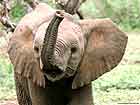
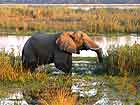
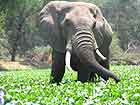
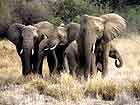
Our premier wildlife screensaver, "African Elephants - Giants of the Wild", can now be downloaded and installed free, with no restrictions.
The screensaver features 60 professional-quality photographs, each one taken in the animals' natural habitat. These are not pictures of tame animals taken in zoos or animal parks! Although this product was previously priced at $14.95, it is now offered as a free download - as a way of saying "thank you" to all of you who regularly visit this website.
The photographs - including mothers and their young, big bull elephants, and fascinating close-ups - illustrate the strong family bonds, intelligence, and immense power of these majestic animals. You can find out more about the Giants of the Wild Screensaver and download it from here.
|
Today's Picture: Little Bee-Eater
April 17, 2007
|
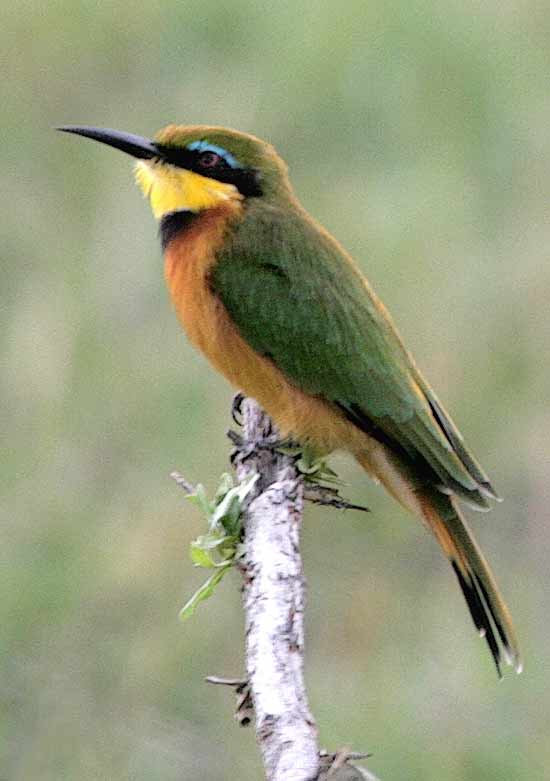
Photo Details: Little Bee-Eater (Merops pusillus) on branch, Moremi Game Reserve,
Botswana.
Camera: Canon EOS 400D; Lens: Canon 100-400 IS Zoom; Focal Length: 400mm; Shutter
speed: 1/320; Aperture: f5.6; ISO: 400.
Additional Info: The Little bee-eater (17cm), as the name suggests, is the smallest of the
bee-eaters found in southern Africa. The others are the Carmine bee-eater (33-38cm), European bee-eater
(25-29cm), Whitefronted bee-eater (22-24cm), Bluecheeked bee-eater (27-33cm) and the Olive bee-eater
(29-33cm).
Because of their relatively small size and constant flitting around, bee-eaters are not easy to photograph,
although their vibrant colors make them especially attractive subjects for photographers (hey, I'm just trying to explain why the above pic is not as sharp as it should be).
There are pictures in the Gallery section of the Whitefronted bee-eater and Carmine bee-eater.
|
Today's Picture: Red Lechwe
April 22, 2007
|
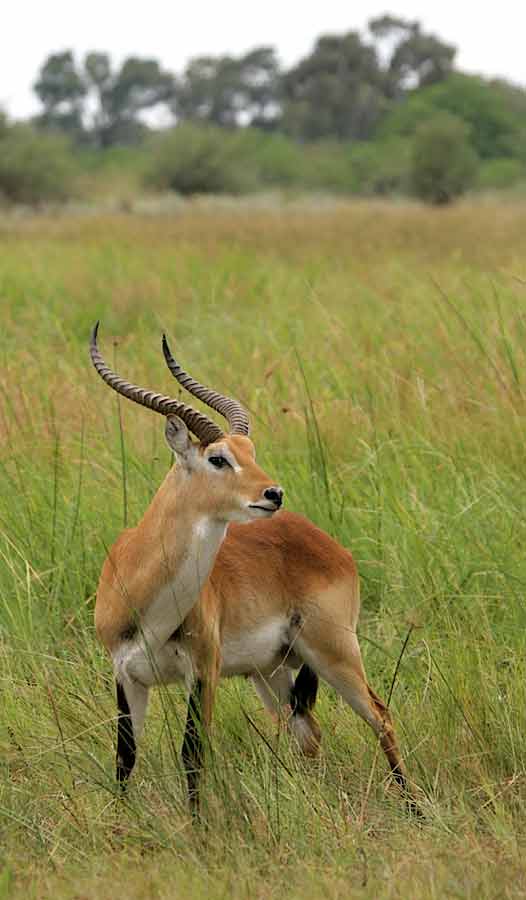
Photo Details: Red Lechwe ram (Kobus leche) standing in marshy wetland, Khwai
River area, Moremi Game Reserve, Botswana.
Camera: Canon EOS 400D; Lens: Canon 100-400 IS Zoom; Focal Length: 200mm; Shutter speed: 1/400; Aperture: f5.6; ISO: 200.
Additional Info: In the photograph above I have deliberately included some background detail to show the typical habitat in which this
attractive, medium-sized antelope is found in Botswana's Okavango Delta.
Only the lechwe males have the ringed, lyrate horns as in the specimen above, while the coat of both males and females is quite coarse, ranging in color from bright chestnut to fawn, with lighter underparts. Although this fellow was on his own, these antelope are known to be gregarious and can sometimes be seen gathered in herds of more than a hundred.
Red lechwe are found only in permanent swamps and wetland where they feed on grass and water plants, often with their heads submerged. Water also provides safety against predators and they will flee towards water when threatened, running with a bounding action as they lift their hindlegs
to clear the surface. If the water is too deep for running in this way, the lechwe will swim instead.
|
Today's Picture: Kudu and Giraffe at Waterhole
April 23, 2007
|
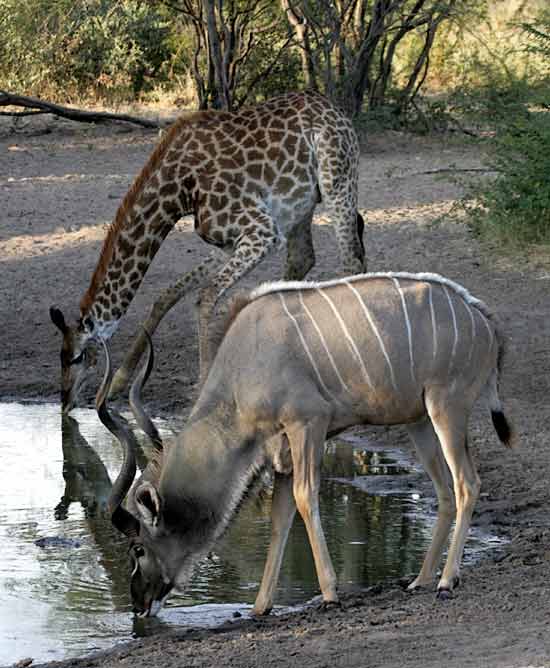
Photo Details: Kudu bull (Tragelaphus strepsiceros) and Giraffe (Giraffa camelopardalis) slake their thirst together at a small waterhole, Khama Rhino Sanctuary, Botswana.
Camera: Canon EOS 400D; Lens: Canon 100-400 IS Zoom; Focal Length: 100mm; Shutter speed: 1/160; Aperture: f5.6; ISO: 400.
Additional Info: Although the kudu bull arrived first, he was only in this position - drinking at the same time as the giraffe - for an instant before darting off, apparently not happy to have company. I was only able to snatch two pictures of this scene and then the antelope was gone.
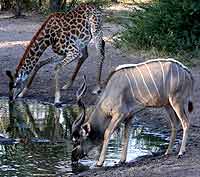 Unfortunately my positioning was not ideal and as a result the kudu's horns protrude across the giraffe's neck and one leg. My friend Andrew Findlay, who was slightly to my left, got a better picture with the kudu's horns positioned neatly between the giraffe's back legs (see right). It's important to look for these small compositional elements when taking any type of photograph, although it's not always possible to change your position and/or focal length as you'd like. I try to grab a picture or two while the opportunity is there, then look to improve and vary the composition.
Unfortunately my positioning was not ideal and as a result the kudu's horns protrude across the giraffe's neck and one leg. My friend Andrew Findlay, who was slightly to my left, got a better picture with the kudu's horns positioned neatly between the giraffe's back legs (see right). It's important to look for these small compositional elements when taking any type of photograph, although it's not always possible to change your position and/or focal length as you'd like. I try to grab a picture or two while the opportunity is there, then look to improve and vary the composition.
Please Note: Pictures displayed on this blog are copyright protected. View them online, enjoy them, but kindly do not use them for anything else. Should you wish to purchase an image or require clarification on use, please contact me.
|
| |
| Back to top of page
|
|
Previous Entries
By Month
By Category
My Original Blog
2005 Entries
2004 Entries
2003 Entries
Who Am I?
Brief Bio
|











 Unfortunately my positioning was not ideal and as a result the kudu's horns protrude across the giraffe's neck and one leg. My friend Andrew Findlay, who was slightly to my left, got a better picture with the kudu's horns positioned neatly between the giraffe's back legs (see right). It's important to look for these small compositional elements when taking any type of photograph, although it's not always possible to change your position and/or focal length as you'd like. I try to grab a picture or two while the opportunity is there, then look to improve and vary the composition.
Unfortunately my positioning was not ideal and as a result the kudu's horns protrude across the giraffe's neck and one leg. My friend Andrew Findlay, who was slightly to my left, got a better picture with the kudu's horns positioned neatly between the giraffe's back legs (see right). It's important to look for these small compositional elements when taking any type of photograph, although it's not always possible to change your position and/or focal length as you'd like. I try to grab a picture or two while the opportunity is there, then look to improve and vary the composition.